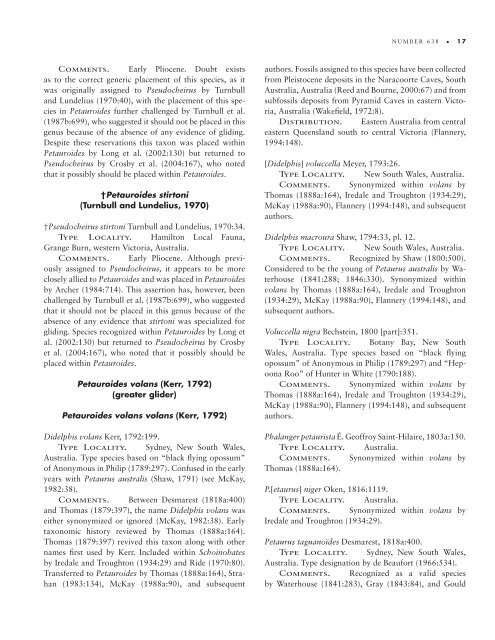Gliding Mammals: Taxonomy of Living and Extinct Species
Gliding Mammals: Taxonomy of Living and Extinct Species
Gliding Mammals: Taxonomy of Living and Extinct Species
You also want an ePaper? Increase the reach of your titles
YUMPU automatically turns print PDFs into web optimized ePapers that Google loves.
comments. Early Pliocene. Doubt exists<br />
as to the correct generic placement <strong>of</strong> this species, as it<br />
was originally assigned to Pseudocheirus by Turnbull<br />
<strong>and</strong> Lundelius (1970:40), with the placement <strong>of</strong> this species<br />
in Petauroides further challenged by Turnbull et al.<br />
(1987b:699), who suggested it should not be placed in this<br />
genus because <strong>of</strong> the absence <strong>of</strong> any evidence <strong>of</strong> gliding.<br />
Despite these reservations this taxon was placed within<br />
Petauroides by Long et al. (2002:130) but returned to<br />
Pseudocheirus by Crosby et al. (2004:167), who noted<br />
that it possibly should be placed within Petauroides.<br />
†Petauroides stirtoni<br />
(Turnbull <strong>and</strong> Lundelius, 1970)<br />
†Pseudocheirus stirtoni Turnbull <strong>and</strong> Lundelius, 1970:34.<br />
type Locality. Hamilton Local Fauna,<br />
Grange Burn, western Victoria, Australia.<br />
comments. Early Pliocene. Although previously<br />
assigned to Pseudocheirus, it appears to be more<br />
closely allied to Petauroides <strong>and</strong> was placed in Petauroides<br />
by Archer (1984:714). This assertion has, however, been<br />
challenged by Turnbull et al. (1987b:699), who suggested<br />
that it should not be placed in this genus because <strong>of</strong> the<br />
absence <strong>of</strong> any evidence that stirtoni was specialized for<br />
gliding. <strong>Species</strong> recognized within Petauroides by Long et<br />
al. (2002:130) but returned to Pseudocheirus by Crosby<br />
et al. (2004:167), who noted that it possibly should be<br />
placed within Petauroides.<br />
Petauroides volans (Kerr, 1792)<br />
(greater glider)<br />
Petauroides volans volans (Kerr, 1792)<br />
Didelphis volans Kerr, 1792:199.<br />
type Locality. Sydney, New South Wales,<br />
Australia. Type species based on “black flying opossum”<br />
<strong>of</strong> Anonymous in Philip (1789:297). Confused in the early<br />
years with Petaurus australis (Shaw, 1791) (see McKay,<br />
1982:38).<br />
comments. Between Desmarest (1818a:400)<br />
<strong>and</strong> Thomas (1879:397), the name Didelphis volans was<br />
either synonymized or ignored (McKay, 1982:38). Early<br />
taxonomic history reviewed by Thomas (1888a:164).<br />
Thomas (1879:397) revived this taxon along with other<br />
names first used by Kerr. Included within Schoinobates<br />
by Iredale <strong>and</strong> Troughton (1934:29) <strong>and</strong> Ride (1970:80).<br />
Transferred to Petauroides by Thomas (1888a:164), Strahan<br />
(1983:134), McKay (1988a:90), <strong>and</strong> subsequent<br />
NUMBER 638 • 17<br />
authors. Fossils assigned to this species have been collected<br />
from Pleistocene deposits in the Naracoorte Caves, South<br />
Australia, Australia (Reed <strong>and</strong> Bourne, 2000:67) <strong>and</strong> from<br />
subfossils deposits from Pyramid Caves in eastern Victoria,<br />
Australia (Wakefield, 1972:8).<br />
distribution. Eastern Australia from central<br />
eastern Queensl<strong>and</strong> south to central Victoria (Flannery,<br />
1994:148).<br />
[Didelphis] voluccella Meyer, 1793:26.<br />
type Locality. New South Wales, Australia.<br />
comments. Synonymized within volans by<br />
Thomas (1888a:164), Iredale <strong>and</strong> Troughton (1934:29),<br />
McKay (1988a:90), Flannery (1994:148), <strong>and</strong> subsequent<br />
authors.<br />
Didelphis macroura Shaw, 1794:33, pl. 12.<br />
type Locality. New South Wales, Australia.<br />
comments. Recognized by Shaw (1800:500).<br />
Considered to be the young <strong>of</strong> Petaurus australis by Waterhouse<br />
(1841:288; 1846:330). Synonymized within<br />
volans by Thomas (1888a:164), Iredale <strong>and</strong> Troughton<br />
(1934:29), McKay (1988a:90), Flannery (1994:148), <strong>and</strong><br />
subsequent authors.<br />
Voluccella nigra Bechstein, 1800 [part]:351.<br />
type Locality. Botany Bay, New South<br />
Wales, Australia. Type species based on “black flying<br />
opossum” <strong>of</strong> Anonymous in Philip (1789:297) <strong>and</strong> “Hepoona<br />
Roo” <strong>of</strong> Hunter in White (1790:188).<br />
comments. Synonymized within volans by<br />
Thomas (1888a:164), Iredale <strong>and</strong> Troughton (1934:29),<br />
McKay (1988a:90), Flannery (1994:148), <strong>and</strong> subsequent<br />
authors.<br />
Phalanger petaurista É. Ge<strong>of</strong>froy Saint- Hilaire, 1803a:150.<br />
type Locality. Australia.<br />
comments. Synonymized within volans by<br />
Thomas (1888a:164).<br />
P.[etaurus] niger Oken, 1816:1119.<br />
type Locality. Australia.<br />
comments. Synonymized within volans by<br />
Iredale <strong>and</strong> Troughton (1934:29).<br />
Petaurus taguanoïdes Desmarest, 1818a:400.<br />
type Locality. Sydney, New South Wales,<br />
Australia. Type designation by de Beaufort (1966:534).<br />
comments. Recognized as a valid species<br />
by Waterhouse (1841:283), Gray (1843:84), <strong>and</strong> Gould

















